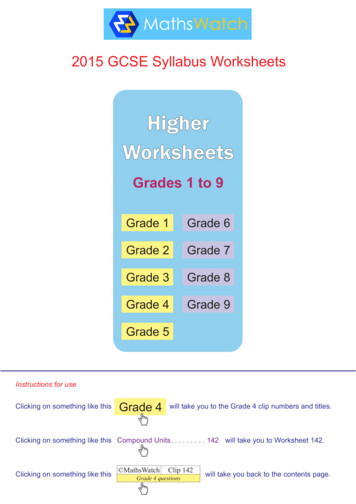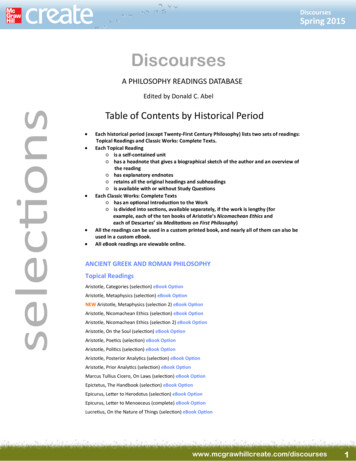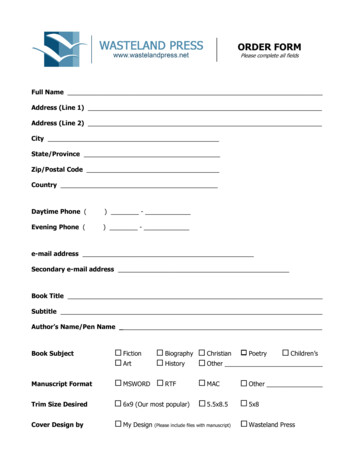
Transcription
2015 GCSE Syllabus WorksheetsHigherWorksheetsGrades 1 to 9Grade 1Grade 6Grade 2Grade 7Grade 3Grade 8Grade 4Grade 9Grade 5Instructions for useClicking on something like thisGrade 4will take you to the Grade 4 clip numbers and titles.Clicking on something like this Compound Units. . . . . . . . . 142 will take you to Worksheet 142.Clicking on something like this MathsWatchClip 142Grade 4 questionswill take you back to the contents page.
Take me to . . .Grade 1Grade 2Grade 3Grade 4Grade 6Grade 7Grade 8Grade 9Grade 5Grade 1 Foundation and HigherPlace Value . . . . . . . . . . . . . . . . . . . . . . . . . . . . . . . . 1Ordering Integers . . . . . . . . . . . . . . . . . . . . . . . . . . . . 2Ordering Decimals . . . . . . . . . . . . . . . . . . . . . . . . . . . 3Reading Scales . . . . . . . . . . . . . . . . . . . . . . . . . . . . . 4Simple Mathematical Notation . . . . . . . . . . . . . . . . . . 5Interpreting Real-Life Tables . . . . . . . . . . . . . . . . . . . 6Introduction to Algebraic Conventions . . . . . . . . . . . . 7Coordinates . . . . . . . . . . . . . . . . . . . . . . . . . . . . . . . . 8Simple Geometric Definitions. . . . . . . . . . . . . . . . . . . 9Polygons . . . . . . . . . . . . . . . . . . . . . . . . . . . . . . . . . 10Symmetries . . . . . . . . . . . . . . . . . . . . . . . . . . . . . . . 11Tessellations and Congruent Shapes. . . . . . . . . . . . 12Names of Angles . . . . . . . . . . . . . . . . . . . . . . . . . . . 13The Probability Scale . . . . . . . . . . . . . . . . . . . . . . . . 14Tally Charts and Bar Charts . . . . . . . . . . . . . . . . . . . 15Pictograms . . . . . . . . . . . . . . . . . . . . . . . . . . . . . . . . 16
Take me to . . .Grade 1Grade 2Grade 3Grade 4Grade 6Grade 7Grade 8Grade 9Grade 5Grade 2 Foundation and HigherAdding Integers and Decimals . . . . . . . . . . . . . . . . . 17Subtracting Integers and Decimals . . . . . . . . . . . . . 18Multiplying Integers . . . . . . . . . . . . . . . . . . . . . . . . . 19Dividing Integers . . . . . . . . . . . . . . . . . . . . . . . . . . . 20Inverse Operations. . . . . . . . . . . . . . . . . . . . . . . . . . 21Money Questions . . . . . . . . . . . . . . . . . . . . . . . . . . . 22Negatives in Real Life . . . . . . . . . . . . . . . . . . . . . . . 23Introduction to Fractions. . . . . . . . . . . . . . . . . . . . . . 24Equivalent Fractions. . . . . . . . . . . . . . . . . . . . . . . . . 25Simplifying Fractions . . . . . . . . . . . . . . . . . . . . . . . . 26Half-Way Values. . . . . . . . . . . . . . . . . . . . . . . . . . . . 27Factors, Multiples and Primes . . . . . . . . . . . . . . . . . 28Introduction to Powers/Indices . . . . . . . . . . . . . . . . . 29Multiply and Divide by Powers of 10 . . . . . . . . . . . . 30Rounding to the Nearest 10, 100 etc . . . . . . . . . . . . 31Rounding to Decimal Places . . . . . . . . . . . . . . . . . . 32Simplifying - Addition and Subtraction . . . . . . . . . . . 33Simplifying - Multiplication . . . . . . . . . . . . . . . . . . . . 34Simplifying - Division . . . . . . . . . . . . . . . . . . . . . . . . 35 A/BFunction Machines . . . . . . . . . . . . . . . . . . . . . . . . . . 36Generating a Sequence - Term to Term . . . . . . . . . . 37Introduction to Ratio . . . . . . . . . . . . . . . . . . . . . . . . . 38Using Ratio for Recipe Questions . . . . . . . . . . . . . . 39Introduction to Percentages . . . . . . . . . . . . . . . . . . . 40Value for Money . . . . . . . . . . . . . . . . . . . . . . . . . . . . 41Introduction to Proportion. . . . . . . . . . . . . . . . . . . . . 42Grade 2 continued
Take me to . . .Grade 1Grade 2Grade 3Grade 4Grade 6Grade 7Grade 8Grade 9Grade 5Grade 2 Foundation and HigherProperties of Solids . . . . . . . . . . . . . . . . . . . . . . . . . 43Nets . . . . . . . . . . . . . . . . . . . . . . . . . . . . . . . . . . . . . 44Angles on a Line and at a Point . . . . . . . . . . . . . . . . 45Measuring and Drawing Angles . . . . . . . . . . . . . . . . 46Drawing a Triangle Using a Protractor . . . . . . . . . . . 47Reflections . . . . . . . . . . . . . . . . . . . . . . . . . . . . . . . . 48Rotations . . . . . . . . . . . . . . . . . . . . . . . . . . . . . . . . . 49Translations . . . . . . . . . . . . . . . . . . . . . . . . . . . . . . . 50Plans and Elevations . . . . . . . . . . . . . . . . . . . . . . . . 51A/B/C/DPerimeters . . . . . . . . . . . . . . . . . . . . . . . . . . . . . . . . 52Area of a Rectangle . . . . . . . . . . . . . . . . . . . . . . . . . 53Area of a Triangle. . . . . . . . . . . . . . . . . . . . . . . . . . . 54Area of a Parallelogram . . . . . . . . . . . . . . . . . . . . . . 55Area of a Trapezium. . . . . . . . . . . . . . . . . . . . . . . . . 56Frequency Trees . . . . . . . . . . . . . . . . . . . . . . . . . . . 57Listing Outcomes . . . . . . . . . . . . . . . . . . . . . . . . . . . 58Calculating Probabilities. . . . . . . . . . . . . . . . . . . . . . 59Mutually Exclusive Events . . . . . . . . . . . . . . . . . . . . 60Two-Way Tables . . . . . . . . . . . . . . . . . . . . . . . . . . . . 61Averages and the Range . . . . . . . . . . . . . . . . . . . . . 62Data - Discrete and Continuous . . . . . . . . . . . . . . . . 63Vertical Line Charts . . . . . . . . . . . . . . . . . . . . . . . . . 64Frequency Tables and Diagrams . . . . . . . . . . . . . . . 65
Take me to . . .Grade 1Grade 2Grade 3Grade 4Grade 6Grade 7Grade 8Grade 9Grade 5Grade 3 Foundation and HigherMultiplying Decimals . . . . . . . . . . . . . . . . . . . . . . . . 66Dividing Decimals. . . . . . . . . . . . . . . . . . . . . . . . . . . 67Four Rules of Negatives. . . . . . . . . . . . . . . . . . . . . . 68Listing Strategies . . . . . . . . . . . . . . . . . . . . . . . . . . . 69Comparing Fractions . . . . . . . . . . . . . . . . . . . . . . . . 70Adding and Subtracting Fractions . . . . . . . . . . . . . . 71Finding a Fraction of an Amount . . . . . . . . . . . . . . . 72Multiplying Fractions . . . . . . . . . . . . . . . . . . . . . . . . 73Dividing Fractions. . . . . . . . . . . . . . . . . . . . . . . . . . . 74BODMAS/BIDMAS. . . . . . . . . . . . . . . . . . . . . . . . . . 75Reciprocals . . . . . . . . . . . . . . . . . . . . . . . . . . . . . . . 76Calculator Questions . . . . . . . . . . . . . . . . . . . . . . . . 77Product of Primes. . . . . . . . . . . . . . . . . . . . . . . . . . . 78Highest Common Factor (HCF) . . . . . . . . . . . . . . . . 79Lowest Common Multiple (LCM) . . . . . . . . . . . . . . . 80 A/BSquares, Cubes and Roots . . . . . . . . . . . . . . . . . . . 81Working with Indices . . . . . . . . . . . . . . . . . . . . . . . . 82Standard Form . . . . . . . . . . . . . . . . . . . . . . . . . . . . . 83Decimals and Fractions . . . . . . . . . . . . . . . . . . . . . . 84Fractions, Percentages, Decimals . . . . . . . . . . . . . . 85Percentage of an Amount (Calc.) . . . . . . . . . . . . . . . 86Percentage of an Amount (Non-Calc.) . . . . . . . . . . . 87Change to a Percentage (Calc.). . . . . . . . . . . . . . . . 88Change to a Percentage (Non-Calc). . . . . . . . . . . . 89 A/BRounding to Significant Figures . . . . . . . . . . . . . . . . 90Estimating Answers . . . . . . . . . . . . . . . . . . . . . . . . . 91Using Place Value . . . . . . . . . . . . . . . . . . . . . . . . . . 92Grade 3 continued
Take me to . . .Grade 1Grade 2Grade 3Grade 4Grade 6Grade 7Grade 8Grade 9Grade 5Grade 3 Foundation and HigherExpanding Brackets . . . . . . . . . . . . . . . . . . . . . . . . . 93Simple Factorisation. . . . . . . . . . . . . . . . . . . . . . . . . 94Substitution . . . . . . . . . . . . . . . . . . . . . . . . . . . . . . . 95Straight Line Graphs . . . . . . . . . . . . . . . . . . . . . . . . 96 A/B/CThe Gradient of a Line . . . . . . . . . . . . . . . . . . . . . . . 97Drawing Quadratic Graphs. . . . . . . . . . . . . . . . . . . . 98 A/B/C/D/ESketching Functions. . . . . . . . . . . . . . . . . . . . . . . . . 99Solving Equations Using Flowcharts . . . . . . . . . . . 100Subject of a Formula Using Flowcharts . . . . . . . . . 101Generate a Sequence from the nth Term. . . . . . . . 102Finding the nth Term . . . . . . . . . . . . . . . . . . . . . . . 103 A/B/CSpecial Sequences . . . . . . . . . . . . . . . . . . . . . . . . 104Exchanging Money. . . . . . . . . . . . . . . . . . . . . . . . . 105Sharing Using Ratio . . . . . . . . . . . . . . . . . . . . . . . . 106Ratios, Fractions and Graphs . . . . . . . . . . . . . . . . 107Increase/Decrease by a Percentage . . . . . . . . . . . 108Percentage Change . . . . . . . . . . . . . . . . . . . . . . . . 109Reverse Percentage Problems . . . . . . . . . . . . . . . 110Simple Interest . . . . . . . . . . . . . . . . . . . . . . . . . . . . 111Grade 3 continued
Take me to . . .Grade 1Grade 2Grade 3Grade 4Grade 6Grade 7Grade 8Grade 9Grade 5Grade 3 Foundation and HigherMetric Conversions. . . . . . . . . . . . . . . . . . . . . . . . . 112Problems on Coordinate Axes . . . . . . . . . . . . . . . . 113Surface Area of a Prism . . . . . . . . . . . . . . . . . . . . . 114 A/BVolume of a Cuboid . . . . . . . . . . . . . . . . . . . . . . . . 115Circle Definitions . . . . . . . . . . . . . . . . . . . . . . . . . . 116Area of a Circle. . . . . . . . . . . . . . . . . . . . . . . . . . . . 117Circumference of a Circle . . . . . . . . . . . . . . . . . . . . 118 A/B/CVolume of a Prism . . . . . . . . . . . . . . . . . . . . . . . . . 119 A/BAngles and Parallel Lines. . . . . . . . . . . . . . . . . . . . 120 A/B/CAngles in a Triangle . . . . . . . . . . . . . . . . . . . . . . . . 121Properties of Special Triangles . . . . . . . . . . . . . . . 122Angle Sum of Polygons . . . . . . . . . . . . . . . . . . . . . 123 A/BBearings . . . . . . . . . . . . . . . . . . . . . . . . . . . . . . . . . 124 A/BExperimental Probabilities . . . . . . . . . . . . . . . . . . . 125Possibility Spaces . . . . . . . . . . . . . . . . . . . . . . . . . 126Venn Diagrams. . . . . . . . . . . . . . . . . . . . . . . . . . . . 127Representing Data . . . . . . . . . . . . . . . . . . . . . . . . . 128Scatter Diagrams . . . . . . . . . . . . . . . . . . . . . . . . . . 129 A/B/C/DAverages From a Table . . . . . . . . . . . . . . . . . . . . . 130
Take me to . . .Grade 1Grade 2Grade 3Grade 4Grade 6Grade 7Grade 8Grade 9Grade 5Grade 4 Foundation and HigherIndex Notation . . . . . . . . . . . . . . . . . . . . . . . . . . . . 131 A/BIntroduction to Bounds . . . . . . . . . . . . . . . . . . . . . . 132Midpoint of a Line on a Graph . . . . . . . . . . . . . . . . 133Expanding and Simplifying Brackets . . . . . . . . . . . 134 A/BSolving Equations . . . . . . . . . . . . . . . . . . . . . . . . . 135Rearranging Simple Formulae . . . . . . . . . . . . . . . . 136Forming Formulae and Equations . . . . . . . . . . . . . 137 A/B/CInequalities on a Number Line . . . . . . . . . . . . . . . . 138Solving Linear Inequalities . . . . . . . . . . . . . . . . . . . 139 A/BSimultaneous Equations Graphically . . . . . . . . . . . 140Fibonacci Sequences. . . . . . . . . . . . . . . . . . . . . . . 141Compound Units . . . . . . . . . . . . . . . . . . . . . . . . . . 142 A/BDistance-Time Graphs . . . . . . . . . . . . . . . . . . . . . . 143Similar Shapes . . . . . . . . . . . . . . . . . . . . . . . . . . . . 144 A/B/CBisecting an Angle . . . . . . . . . . . . . . . . . . . . . . . . . 145Constructing Perpendiculars . . . . . . . . . . . . . . . . . 146Drawing a Triangle Using Compasses . . . . . . . . . . 147Enlargements . . . . . . . . . . . . . . . . . . . . . . . . . . . . . 148Tangents, Arcs, Sectors and Segments . . . . . . . . . 149Pythagoras’ Theorem . . . . . . . . . . . . . . . . . . . . . . . 150 A/B/CSimple Tree Diagrams . . . . . . . . . . . . . . . . . . . . . . 151 A/B/CSampling Populations . . . . . . . . . . . . . . . . . . . . . . 152Time Series . . . . . . . . . . . . . . . . . . . . . . . . . . . . . . 153
Take me to . . .Grade 1Grade 2Grade 3Grade 4Grade 6Grade 7Grade 8Grade 9Grade 5Grade 5 Foundation and HigherNegative Indices. . . . . . . . . . . . . . . . . . . . . . . . . . . 154Error Intervals. . . . . . . . . . . . . . . . . . . . . . . . . . . . . 155Mathematical Reasoning . . . . . . . . . . . . . . . . . . . . 156Factorising and Solving Quadratics . . . . . . . . . . . . 157The Difference of Two Squares . . . . . . . . . . . . . . . 158Finding the Equation of a Straight Line . . . . . . . . . 159 A/BRoots and Turning Points of Quadratics . . . . . . . . 160Cubic and Reciprocal Graphs . . . . . . . . . . . . . . . . 161Simultaneous Equations Algebraically . . . . . . . . . . 162Geometric Progressions. . . . . . . . . . . . . . . . . . . . . 163Compound Interest and Depreciation . . . . . . . . . . 164Loci. . . . . . . . . . . . . . . . . . . . . . . . . . . . . . . . . . . . . 165 A/B/CCongruent Triangles. . . . . . . . . . . . . . . . . . . . . . . . 166 A/BSectors of a Circle . . . . . . . . . . . . . . . . . . . . . . . . . 167Trigonometry . . . . . . . . . . . . . . . . . . . . . . . . . . . . . 168 A/B/C/D/ESpheres . . . . . . . . . . . . . . . . . . . . . . . . . . . . . . . . . 169Pyramids . . . . . . . . . . . . . . . . . . . . . . . . . . . . . . . . 170Cones. . . . . . . . . . . . . . . . . . . . . . . . . . . . . . . . . . . 171 A/B/CFrustums . . . . . . . . . . . . . . . . . . . . . . . . . . . . . . . . 172Exact Trigonometric Values . . . . . . . . . . . . . . . . . . 173Introduction to Vectors . . . . . . . . . . . . . . . . . . . . . . 174Harder Tree Diagrams . . . . . . . . . . . . . . . . . . . . . . 175 A/B/CStratified Sampling . . . . . . . . . . . . . . . . . . . . . . . . . 176 A/B
Take me to . . .Grade 1Grade 2Grade 3Grade 4Grade 6Grade 7Grade 8Grade 9Grade 5Grade 6 HigherRecurring Decimals to Fractions . . . . . . . . . . . . . . 177Product of Three Binomials . . . . . . . . . . . . . . . . . . 178Iteration - Trial and Improvement . . . . . . . . . . . . . . 179Iterative Processes. . . . . . . . . . . . . . . . . . . . . . . . . 180Enlargement - Negative Scale Factor. . . . . . . . . . . 181Combinations of Transformations . . . . . . . . . . . . . 182 A/B/C/D/EF/G/H/I/JCircle Theorems . . . . . . . . . . . . . . . . . . . . . . . . . . . 183 A/B/C/D/E/FProof of Circle Theorems . . . . . . . . . . . . . . . . . . . . 184Probability Using Venn Diagrams. . . . . . . . . . . . . . 185Cumulative Frequency . . . . . . . . . . . . . . . . . . . . . . 186 A/B/C/D/E/FBoxplots . . . . . . . . . . . . . . . . . . . . . . . . . . . . . . . . . 187 A/B/C/D
Take me to . . .Grade 1Grade 2Grade 3Grade 4Grade 6Grade 7Grade 8Grade 9Grade 5Grade 7 HigherFractional Indices . . . . . . . . . . . . . . . . . . . . . . . . . . 188Recurring Decimals - Proof . . . . . . . . . . . . . . . . . . 189Rearranging Difficult Formulae . . . . . . . . . . . . . . . 190Solving Quadratics with the Formula . . . . . . . . . . . 191Factorising Hard Quadratics . . . . . . . . . . . . . . . . . 192Algebraic Proof. . . . . . . . . . . . . . . . . . . . . . . . . . . . 193Exponential Functions . . . . . . . . . . . . . . . . . . . . . . 194Trigonometric Graphs. . . . . . . . . . . . . . . . . . . . . . . 195 A/BTransformation of Functions. . . . . . . . . . . . . . . . . . 196 A/B/C/D/EEquation of a Circle . . . . . . . . . . . . . . . . . . . . . . . . 197Regions . . . . . . . . . . . . . . . . . . . . . . . . . . . . . . . . . 198Direct and Inverse Proportion. . . . . . . . . . . . . . . . . 199 A/BSimilarity - Area and Volume . . . . . . . . . . . . . . . . . 200The Sine Rule . . . . . . . . . . . . . . . . . . . . . . . . . . . . 201The Cosine Rule . . . . . . . . . . . . . . . . . . . . . . . . . . 202Area of a Triangle Using Sine . . . . . . . . . . . . . . . . 203And and Or Probability Questions . . . . . . . . . . . . . 204Histograms . . . . . . . . . . . . . . . . . . . . . . . . . . . . . . . 205 A/B/C/DE/F/G/H
Take me to . . .Grade 1Grade 2Grade 3Grade 4Grade 6Grade 7Grade 8Grade 9Grade 8Grade 9HigherGrade 5Upper and Lower Bounds . . . . . . . . . . . . . . . . . . . 206 A/B/CSurds . . . . . . . . . . . . . . . . . . . . . . . . . . . . . . . . . . . 207 A/B/CPerpendicular Lines . . . . . . . . . . . . . . . . . . . . . . . . 208Completing the Square . . . . . . . . . . . . . . . . . . . . . 209Algebraic Fractions . . . . . . . . . . . . . . . . . . . . . . . . 210 A/BSimultaneous Equations with a Quadratic . . . . . . . 211Solving Quadratic Inequalities . . . . . . . . . . . . . . . . 212Finding the nth Term of a Quadratic . . . . . . . . . . . . 213Inverse Functions. . . . . . . . . . . . . . . . . . . . . . . . . . 214Composite Functions . . . . . . . . . . . . . . . . . . . . . . . 215Interpreting Graphs. . . . . . . . . . . . . . . . . . . . . . . . . 216Pythagoras in 3D. . . . . . . . . . . . . . . . . . . . . . . . . . 217Trigonometry in 3D. . . . . . . . . . . . . . . . . . . . . . . . . 218Vectors . . . . . . . . . . . . . . . . . . . . . . . . . . . . . . . . . .219 A/B/C/D/E
MathsWatchClip 1Place ValueGrade 1 questions1)a) Write the number forty five thousand, two hundred and seventy three in figures.b) Write the number five thousand, one hundred and three in figures.c) Write the number three hundred thousand, seven hundred and ninety one in figures.d) Write the number two and a half million in figures.e) Write the number one and three quarter million in figures.2)Write the following numbers in wordsa) 1 250b) 3 502c) 72 067d) 192 040e) 30 000 0003)a) Write down the value of the 7 in the number 3 752.b) Write down the value of the 6 in the number 56 025.c) Write down the value of the 2 in the number 99 723.d) Write down the value of the 5 in the number 258 610.e) Write down the value of the 2 in the number 1 253 549.4)What is the value of the digit 7 in 38.1472?Choose, and circle, the correct answer from the following:710710071000710000Page 1
MathsWatchClip 2Grade 1 questionsOrdering IntegersPut these numbers in order, starting with the smallest:1)74, 57, 38, 8, 612)39, 84, 11, 128, 243)76, 102, 12, 140, 734)3, –2, –7, 10, –15)–3, –11, 1, –5, 76)–4, 6, 0, –6, –17)205, 2005, 105, 55, 50058)83, –61, –42, 65, –14Page 2
MathsWatchClip 3Grade 1 questions1)Ordering DecimalsPut these amounts of money in order, starting with the smallest:a) 4.50, 3.82, 4.05, 3.99, 3.54b) 1.25, 2.41, 1.24, 2.04, 1.99c) 15.83, 24.18, 13.99, 46.01, 46.102)Circle the smallest number: 0.1, 0.09, 0.99, 0.15, 0.113)Put these numbers in order, starting with the smallest:2.01, 2.45, 2.14, 2.006, 2.4054)Put these numbers in order, starting with the smallest:0.76, 0.668, 0.608, 0.099, 0.9095)Put these numbers in order, starting with the smallest:5.004, 4.889, 4.099, 5.002, 4.095Page 3
MathsWatchClip 4Reading ScalesGrade 1 questions1)Estimate the reading on each of these scales:a)b)23131404e)400f)2003000402060400 0kg2)4kg1003030kg2010210kgd)c)280kgkgThis scale shows degrees Centigrade. C-20 -10 0 10 20 30 40 a) What temperature is the arrow pointing to?b) Draw an arrow which points to -17 C.3)This is a diagram for converting between gallons and litres.Gallons1Litres23104520Use the diagram to converta) 3 gallons to litres.b) 4.5 gallons to litres.c) 6 litres to gallons.Page 4
MathsWatchClip 5Grade 1 questions1)Simple Mathematical NotationFor each mathematical sign, below, write a brief description of the sign.The first one has already been done.less thana) b) c) d) e) 2)Insert one of the two symbols or to make the following statements true:a) 8 . 5b) -4 . -6c) 2.08 . 2.8d) 8 3 . 2 7e) 2 ? 7 . 5 ? 83)You must be at least 1.6 m tall to ride on a rollercoaster at Romy Park.Circle the correct description of this out of the following:Height 1.6 mHeight 1.6 mHeight 1.6 mHeight 1.6 mHeight 1.6 mPage 5
MathsWatchClip 6Interpreting Real-Life TablesGrade 1 questions1)Calculate the difference in hours and minutes between 9.30 am and 2.45 pm.2)Calculate the difference in hours and minutes between 11 35 and 13 25.3)The table shows the distances in kilometres between some cities in the USA.San Francisco4827New York49902132Miami66845414375Los Angeles3493135221833366Chicagoa) Write down the distance between San Francisco and Miami.One of the cities in the table is 4541 km from Los Angeles.b) Write down the name of this city.c) Write down the name of the city which is furthest from Chicago.4)Here is part of a train ordEuston05 1505 2605 3905 5406 1208 0906 0606 1606 2906 4508 2606 4506 5507 0807 2407 4109 0607 0507 1509 1107 1507 2507 3807 5408 1109 5007 4607 5508 0808 2410 08a) Tim catches the 06 06 train from Manchester.At what time should he expect to arrive at Euston?b) Jenny arrives at the Stockport train station at 07 00(i) How long should she expect to wait for a train to Stoke?(ii) How long should her train journey take?c) Sarah needs to travel to Euston from Macclesfield.She has to arrive at Euston before 09 30.What is the departure time of the latest train she can catch to get there on time?Page 6
MathsWatchClip 7Grade 1 questions1)Introduction to Algebraic ConventionsWrite the following in their simplest formsusing algebraic notation:a) r 5b) c 4c) x x x xd) e 12)Write the following using algebraic notation:a) I think of a numberand multiply it by 4.b) I think of a number,multiply it by 6and then add 5.c) I think of a number,triple itand then subtract 7.3)Write the following using algebraic notation:a) I think of a number,add 2and then multiply the result by 3.b) I think of a number,subtract 6and then divide the result by 2.4)Write the following using algebraic notation:a) I think of a number,add 9,multiply the result by 4and then divide everything by 2.b) I think of a number,take away 5,divide the result by 3and then multiply the result by 2.Page 7
MathsWatchClip 8Grade 1 questionsCoordinatesy10B91) Write down the coordinates of the points A to H.A87C6E54F3DH21GO12345678910xy2) a) Write down the coordinates of:(i) A8(ii) B7b) Write down the coordinates of the midpoint of theline AB.6B543A21O123) Using the pair of axes,a) Plot the points A(2, 0), B(4, 0), C(5, 2) and D(3, 2).345678xy5b) Join the points in order, to forma shape and name the shape.4M is the midpoint of the line segment AC.c) Find the coordinates of M.3214) Using the same pair of axes,a) Plot the points R(-1, -2), S(1, 1)and T(-1, 2).-5-4-3-2-1Ox1234-1b) Join R to S and S to T.-2RSTU is a kite.c) Write the coordinates of point U.-3-4-5Page 85
MathsWatchClip 9Grade 1 questions1)Simple Geometric DefinitionsWrite one or two short sentences which say what the special featuresare of the triangles listed, below.The first one has been done for you.a) An equilateral triangle All the sides are the same length.All three angles are 60 b) A right-angled trianglec) A scalene triangled) An isosceles triangle2)Next to each of the quadrilaterals, write down its special name.a)b)c)d)Page 9
MathsWatchClip 10Grade 1 questions1)Next to each of the shapes, write down its name.a)2)Polygonsb)a) What is the name given to a 10-sided shape?b) What is the name given to an 8-sided shape?3)To be a regular polygon the shape must have equal and equal .Fill in the blanks.4)What are the names of these regular polygons?a)b)Page 10
MathsWatchClip 11SymmetriesGrade 1 questions1)Draw all the lines of symmetry on the triangle and the rectangle.2)What is the order of rotational symmetry of the two shapes below?S3)The diagram below, shows part of a shape.PThe shape has rotational symmetry of order 4 about point P.Complete the shape.4)On each of the shapes below, draw one plane of symmetry.Page 11
MathsWatchClip 12Tessellations and Congruent ShapesGrade 1 questions1)Show how this shape will tessellate.You must draw six more shapes.2)Two of these shapes are congruent.Which are they?a)b)c)e)d)Page 12
MathsWatchClip 13Grade 1 questions1)Names of AnglesWrite the name of each angle, below.a)b)c)d)2)Draw a triangle which contains:a) Three acute angles.b) One obtuse angle and two acute angles.c) A right angle.Page 13
MathsWatchClip 14The Probability ScaleGrade 1 questions1)a) On the probability scale below, mark with a cross ( ) the probabilitythat it will snow in Birmingham in July.0121b) On the probability scale below, mark with a cross ( ) the probabilitythat it will rain in Wales next year.0121c) On the probability scale below, mark with a cross ( ) the probabilitythat you will get a tail when you flip a fair coin.0121d) On the probability scale below, mark with a cross ( ) the probabilitythat you will get a number bigger than 4 when you roll an ordinary dice.02)1214 jelly babies are in a bag.2 are red, 1 is green and 1 is black.Without looking in the bag, a jelly baby is taken out.a) On the probability scale below, mark with a cross ( ) the probabilitythat the jelly baby taken from the bag is green.0121b) On the probability scale below, mark with a cross ( ) the probabilitythat the jelly baby taken from the bag is green or black.0121c) On the probability scale below, mark with a cross ( ) the probabilitythat the jelly baby taken from the bag is red or black.0121Page 14
MathsWatchClip 15Tally Charts and Bar ChartsGrade 1 questions1)Here is a list of coins in Yvonne's purse.Coin5p 120p 1pTallyFrequency50p10p 15p50p 2p5p5p 11p5p 12p5p5p2pComplete the table for this information.2)Tim made a note of how many minutes he spent on the internet over the period of a week.His results are as follows:Monday20 minsTuesday30 minsWednesday 60 minsThursday 40 minsFriday20 minsSaturday50 minsSunday40 minsDraw a bar chart to show this information.Page 15
MathsWatchClip 16Grade 1 questions1)PictogramsThe pictogram shows the number of watches sold by a shop in January,February and March.JanuaryFebruaryKeyrepresents 4 watches.MarchAprilMaya) How many watches were sold in January?b) How many more watches were sold in March than in February?19 watches were sold in April.14 watches were sold in May.c) Use this information to complete the pictogram.2)The pictogram shows the number of DVDs borrowed from a shop on Mondayand Tuesday.MondayTuesdayKeyrepresents 10 DVDs.WednesdayThursdaya) How many DVDs were borrowed on(i)Monday?(ii)Tuesday?On Wednesday, 50 DVDs were borrowed.On Thursday, 15 DVDs were borrowed.b) Show this information in the pictogram.Page 16
MathsWatchClip 17Adding Integers and DecimalsGrade 2 questions1)a)42 2 6b)57 3 8c)96 7 52)a)637 961b)983 442c)969 7583)a) 452 384)There were two exhibitions at the NEC one Sunday.3816 people went to one of the exhibitions and 13427 peoplewent to the other exhibition.How many people went to the NEC, in total, on the Sunday?5)a) 2.6 1.2b) 2.74 6.81c) 45.36 6.816)a) 23 1.5b) 13.6 38c) 13.2 17.82b) 147 763c) 813 431 38Page 17
MathsWatchClip 18Subtracting Integers and DecimalsGrade 2 1b)773–486c)100– 343)a) 653 – 484)5)b) 362 – 183c) 2000 – 461There were two films showing at a cinema one Saturday.One of the films was shown in a large room and the other wasin a smaller room.The film in the larger room was watched by a total of 3562 people.The film in the smaller room was watched by 1671 people.How many more people saw the film in the larger room?a) 782 426 – 278b) 8162 1149 – 799Page 18
MathsWatchClip 19Grade 2 questions1)Multiplying IntegersWork outa) 13 18b) 135 27c) 116 41d) 264 43e) 326 24f) 281 59g) 286 48h) 428 34i) 461 452)“MathsWatch Travel” has 36 coaches.Each of these coaches can carry 53 passengers.How many passengers in total can all the coaches carry?3)“MathsWatch Tours” has a plane that will carry 47 passengers.To fly from Manchester to Lyon, each passenger pays 65Work out the total amount that the passengers pay.4)A Science textbook costs 13.Mr Jones buys a class set of 34 books.How much do they cost him?5)A graphical calculator costs 18.How much would 43 calculators cost?Page 19
MathsWatchClip 20Dividing IntegersGrade 2 questions1)Work outa) 325 5d) 377 29g) 75 4b) 448 8e) 27 6h) 135 20c) 221 13f) 123 15i) 381 122)A box can hold 19 books.Work out how many boxes will be needed to hold 646 books.3)The distance from Glasgow to Paris is 1290 km.A flight from Glasgow to Paris lasts 3 hours.Given thatDistanceAverage speed TimeWork out the average speed of the aeroplane in km/h.4)Pencils cost 25p each.Mr Smith spends 15 on pencils.Work out the number of pencils he gets.5)Yesterday, Gino was paid 19.61 for delivering pizzas.He is paid 53p for each pizza he delivers.Work out how many pizzas Gino delivered yesterday.6)Emma sold 38 teddy bears for a total of 513She sold each teddy bear for the same price.Work out the price at which Emma sold each teddy bear.7)Canal boat for hire 1855.00for 14 daysWork out the cost per day of hiring the canal boat.8)A teacher has 539 to spend on books.Each book costs 26How many books can the teacher buy?9)John delivers large wooden crates with his van.The weight of each crate is 68 kg.The greatest weight the van can hold is 980 kg.Work out the greatest number of crates that the van can hold.Page 20
MathsWatchClip 21Grade 2 questions1)Inverse Operationsa) Which operation is the inverse of ‘add’?b) Which operation is the inverse of ‘divide’?2)3)4)5)Use inverse operations to complete the second equation each time.a)12 6 18? 12b)28 ? 13 15 28Use inverse operations to complete the second equation each time.a)14 2 28 14b)60 12 5 60Use inverse operations to complete the second equation each time.a)19 13 32 19b)46 ? 13 33 46Use inverse operations to complete the second equation each time.a)28 7 4 28b)16 3 48 3Page 21
MathsWatchClip 22Money QuestionsGrade 2 questions1)Tony buys4 kg of potatoes at 1.60 per kilogramand2
Grade 1 Grade 2 Grade 3 Grade 4 Grade 5 Grade 6 Grade 7 Grade 8 Grade 9 2015 GCSE Syllabus Worksheets Clicking on something like this will take you to the Grade 4 clip numbers and titles.











